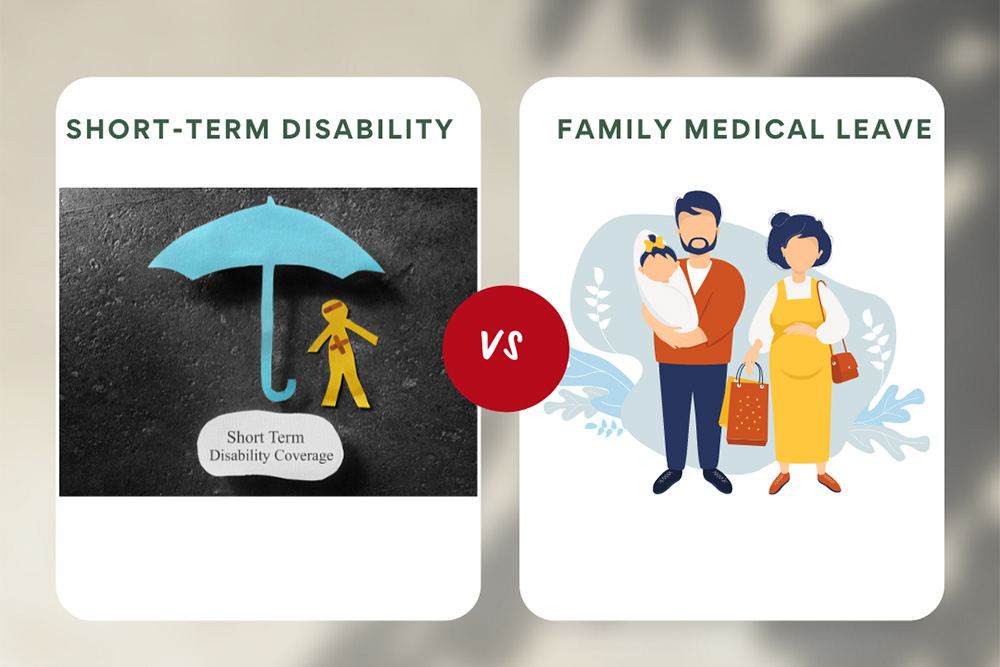When an employee needs to be absent from work for more than a brief period, there are two resources they can turn to protect their employment as well as their income – Short-Term Disability (STD) and Family and Medical Leave. While there is some overlap, there are significant differences between the two. This article will explore the differences between STD and Family Medical Leave.
Table of Contents
What Is Family and Medical Leave?
The Family and Medical Leave Act (FMLA) was a law passed by Congress in 1993 to protect employees who needed to be off work for a period of time from being fired by their employers. The FMLA allows employees up to 12 weeks of leave in a 12-month period for the following:
- The birth of a child or caring for a newborn
- Adoption of a child or placement of a child for foster care
- The serious illness of an employee that prevents the employee from working
- The need to care for an employee’s spouse, child, or parent who has a serious health condition
- An exigency arising out of an employee’s spouse, child, or parent who is in military service
Not every employee is eligible for FMLA. First, the FMLA only applies to employees who have at least 50 employees employed within 75 miles of the employee’s place of work. An employee’s eligibility for FMLA leave is also dependent on having worked for the employer for at least 12 months or 1,250 hours in the 12 months before taking leave.
FMLA leave is unpaid. However, if the employee has health insurance coverage through their employment, the coverage must be continued during FMLA leave. If an employee seeks FMLA leave due to a serious illness or injury, the employee may be required to submit a certification of the need to take leave completed by a physician.
When the employee is ready to return to work during the 12-week leave period, the employee is entitled to reemployment in the same or an equivalent job. However, if the employee’s job is eliminated while the employee is on leave, the employer is not required to create a new job for the employee. Furthermore, if the employee is unable to return to work before the 12-week FMLA period expires, the employer may justifiably terminate the employee so long as the employer maintains a uniform policy of doing so. It is a common misconception that if an employee is on FMLA leave due to a serious illness or injury, their job needs to be held open for them beyond the 12-week FMLA period in accordance with the Americans with Disabilities Act (ADA). It is not an ADA violation for an employer to fire an employee who is unable to return to work after 12 weeks of FMLA leave.
What is Short-Term Disability
Unlike the FMLA, short-term disability is not federally mandated, although some states provide state-sponsored disability benefits that are funded by mandatory employer contributions. Those states are California, Hawaii, New Jersey, New York, and Rhode Island. For residents of states other than those states, short-term disability benefits are available only if the employer sponsors such a program. If the employer offers short-term disability, the employee may qualify for benefits if they are unable to work due to an illness or injury lasting that results in a work absence lasting more than a handful of days. The duration of short-term disability benefits depends on the design of the plan – many plans offer benefits for up to 26 weeks or even up to one year, which provides salary continuation through an “elimination period” the employee would need to complete before long-term disability benefits commence.
The amount of benefits payable under a short-term disability plan is dependent on the plan’s design. Some plans pay full benefits for a number of weeks and then pay a percentage of the employee’s salary up to a maximum amount. Other plans only pay a percentage of salary.
Employees are required to provide medical certification of their inability to work in order to receive short-term disability benefits; and will often be required to re-certify their disability during the short-term disability period.
Disabilities due to workplace injuries are generally excluded from short-term disability. However, in such instances, the employee should be entitled to receive workers’ compensation. If the disability is due to a pre-existing condition, most short-term disability plans provide benefits, but others do not. Unlike health insurance benefits under the Affordable Care Act, pre-existing conditions may be excluded from coverage.
Finally, although long-term disability benefits fall within the scope of the Employee Retirement Income Security Act (ERISA), if the employer self-funds the short-term disability benefits, those benefits may fall outside the scope of ERISA since they are considered a “payroll practice;” i.e., a continuation of salary through the employer’s payroll. However, if the employer has purchased short-term disability insurance, the benefits would be governed by ERIA.
Learn More About How Our Disability Benefits Attorneys Can Help You Get Justice
What Are the Differences Between STD and FMLA?
The biggest difference between FMLA and STD is that leave under the FMLA is unpaid. If an employee is eligible for both FMLA and STD, the two run concurrently, so the employee receives payment while on FMLA. However, an employee may qualify for FMLA leave that is wholly unconnected with the employee’s own disability and would thus not qualify for STD.
Other differences are that employees may not need to meet the qualifying requirements for STD they would have to satisfy for FMLA leave, such as a workplace with at least 50 employees and at least 12 months of working. STD eligibility may commence on the first day of employment.
Qualifying for STD also does not guarantee reemployment, especially after the 12-week FMLA period is exhausted. However, an employee may need to qualify for STD in order to qualify for LTD benefits depending on the language in the LTD plan. Mechanisms for challenging an unjustified denial of STD benefits also differ from how FMLA denials are challenged.
Conclusions
Employees need to know their rights if they are unable to work. If the reason for absence from work is due to an injury or illness, the employee should immediately request FMLA leave but should also inquire about the availability of STD. Qualifying for FMLA does not necessarily qualify an employee for STD and vice versa. Both for job protection and salary protection, employees must determine the benefits available to them, apply for those benefits, and not assume the benefits are automatic.
Nor are STD and FMLA benefits always approved. If an employee believes that either their FMLA or the STD benefits have been unjustifiably denied, they should seek assistance from an experienced benefits attorney who can advise them of their rights and assist them in obtaining the benefits to which they are entitled.







